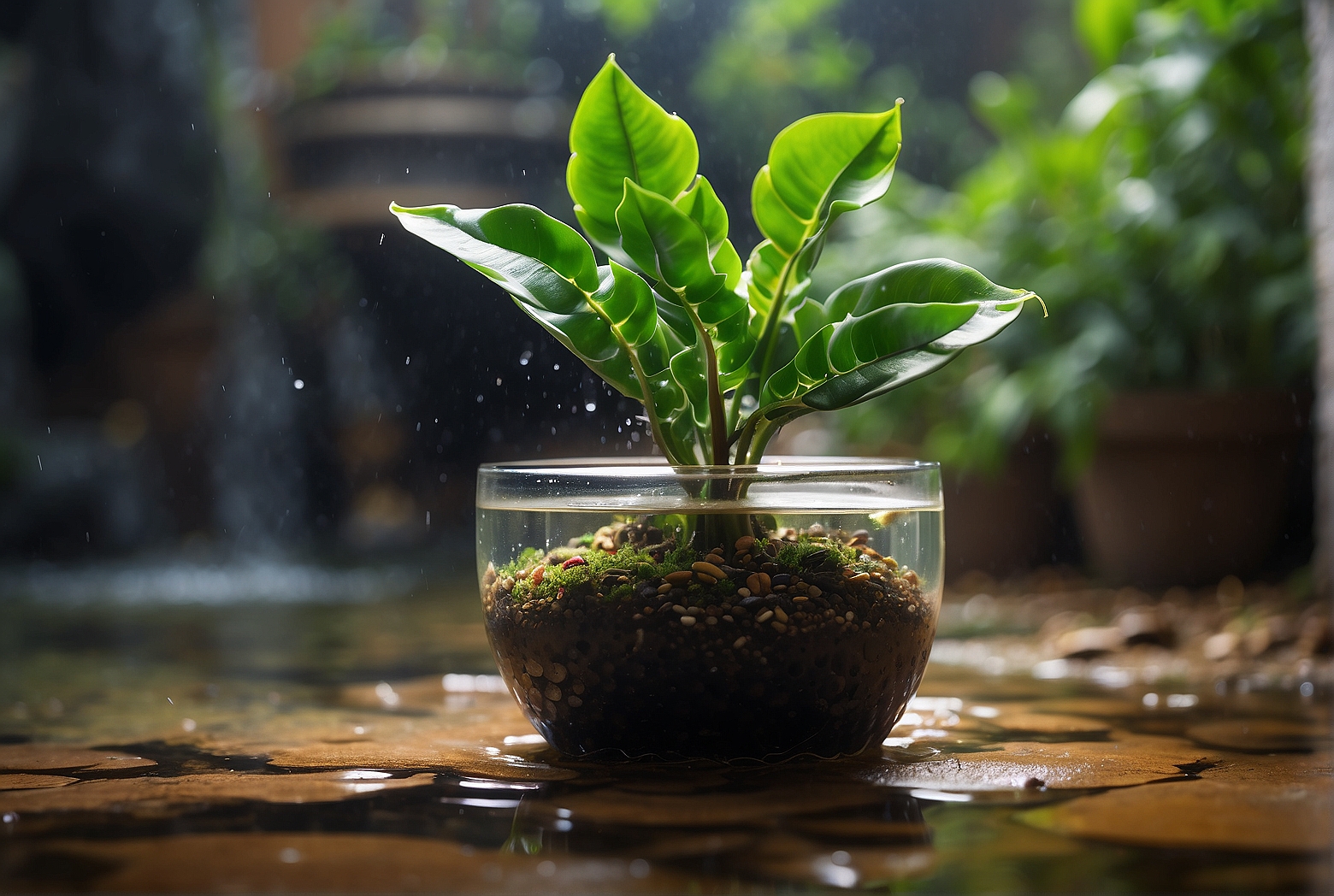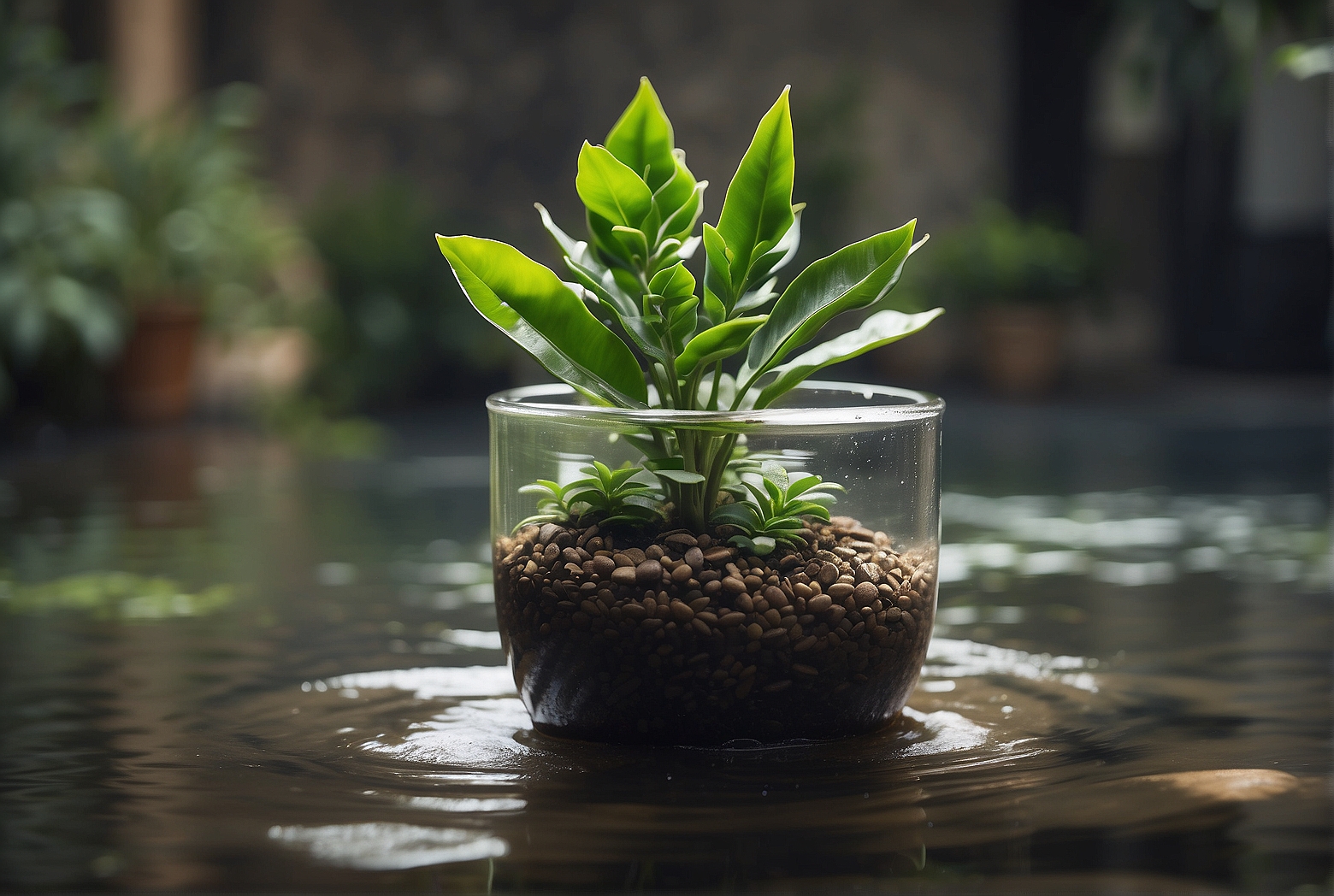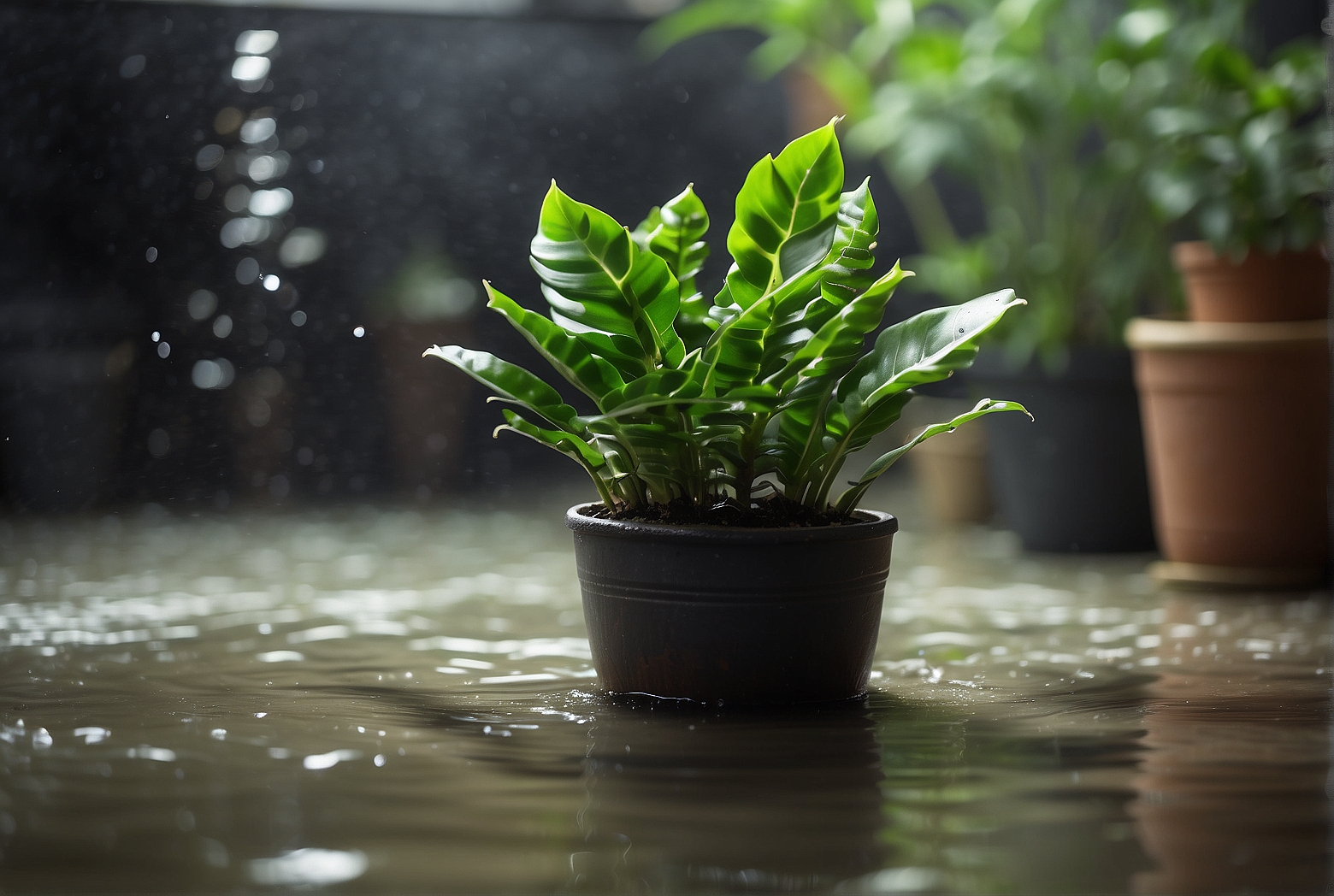Last Updated on April 4, 2024 by Tony Manhart
Are you curious about whether the stylish and low-maintenance ZZ plant can thrive in water? Well, wonder no more! In this article, we will explore the fascinating question of whether ZZ plants can grow in water. Many plant enthusiasts are eager to find out if this already hardy houseplant can adapt to a water-based environment. We’ll provide you with all the information you need to know about the possibility of cultivating a ZZ plant solely in water. So, let’s dive into this intriguing topic and discover the potential of water as a growing medium for these beautiful plants.
Introduction
If you’re looking for an easy and low-maintenance plant to add to your indoor garden, the ZZ plant might be the perfect choice for you. This hardy and versatile plant can thrive in various conditions, including growing in water. In this comprehensive article, we will explore the process of growing and propagating ZZ plants in water, the materials required, and the proper care needed to maintain a healthy and thriving plant. So, let’s dive in and discover the wonders of water propagation with ZZ plants!
What is a ZZ Plant?
Before delving into water propagation, let’s first familiarize ourselves with the ZZ plant. Also known as Zamioculcas zamiifolia, the ZZ plant is a tropical perennial that is native to East Africa. It is well-loved for its lush and shiny foliage, consisting of thick, dark green leaves that resemble feathers.
Description of a ZZ plant
The ZZ plant features thick stalks, which store water and nutrients, and multiple pairs of leaflets that grow from each stem. The leaves are usually around 2-3 feet in length, with a waxy texture that helps them retain moisture. This unique adaptation makes the ZZ plant incredibly drought-tolerant and allows it to thrive in various environments.

Popular varieties of ZZ plants
While the classic ZZ plant is already a stunning addition to any space, there are also a few popular varieties worth mentioning. Some of these include:
- Zamioculcas zamiifolia ‘Raven’: This variety boasts deep purple-black foliage, creating a striking contrast against the usual greenery.
- Zamioculcas zamiifolia ‘Zenzi’: With smaller, compact leaves, this variety is perfect for those with limited space or looking for a more understated look.
- Zamioculcas zamiifolia ‘Variegata’: If you’re looking for a touch of uniqueness, this variety features leaves with creamy white stripes, adding a pop of color to your collection.
Growing ZZ Plants in Water
Now that we have a good understanding of the ZZ plant let’s explore the feasibility of growing it in water and the advantages and disadvantages of water propagation.
Feasibility of growing ZZ plants in water
Growing ZZ plants in water is indeed possible and can be a rewarding process. ZZ plants have a rhizomatous root system, meaning they have thick, fleshy roots that store water. These roots are well-suited for water propagation, as they can absorb moisture efficiently.
Advantages and disadvantages of water propagation
One of the main advantages of water propagation with ZZ plants is the ability to closely monitor the root growth. By growing the plant in water, you can easily observe the development of the roots before transferring it to soil. Water propagation also eliminates the risk of overwatering or underwatering, as the plant always has access to the moisture it needs.

However, it is important to note that ZZ plants grown in water may take longer to establish roots compared to those grown in soil. Additionally, transitioning the plant from water to soil can be a delicate process, requiring proper care and attention to prevent shock or damage to the plant.
Materials Required
Before you start propagating your ZZ plant in water, it’s essential to gather all the necessary materials and set yourself up for success.
List of materials needed for water propagation
Here’s a list of materials you’ll need for propagating a ZZ plant in water:
- Healthy ZZ plant: Choose a mature ZZ plant with healthy leaves and stems for the best chances of successful propagation.
- Clean container: Opt for a clear glass or plastic container that is deep enough to accommodate the roots and has a wide enough opening for easy maintenance.
- Water: Use filtered or distilled water to prevent any harmful chemicals or minerals from affecting the plant’s growth.
- Rooting hormone (optional): To encourage root growth, you may choose to use a rooting hormone specifically formulated for water propagation.
Tips for choosing the right container
When selecting a container for water propagation, keep in mind a few important tips. Choose a container with good stability to avoid any accidental tip-overs. Opt for a container with a narrow neck or opening to support the plant and keep it upright. Finally, make sure the container has enough space for the roots to grow and expand.
Preparing the Plant for Water Propagation
Now that you have gathered your materials, it’s time to prepare the ZZ plant for water propagation. Proper selection and preparation of the plant will increase the chances of success and healthy root development.
Selecting a healthy ZZ plant for propagation
When choosing a ZZ plant for propagation, look for a healthy specimen with vibrant leaves, as this indicates a plant with a strong root system. Avoid plants with wilting or yellowing leaves, as these may struggle to establish roots successfully.
Pruning and cleaning the plant
Before placing your ZZ plant in water, it’s recommended to prune any damaged or diseased leaves to promote healthy growth. Gently remove any debris or dirt from the roots, being careful not to damage or disturb them. This step ensures that the plant is in the best condition to begin the propagation process.
Propagating ZZ Plant in Water
With a healthy ZZ plant and a clean container ready, it’s time to dive into the process of water propagation. Follow these step-by-step instructions to propagate your ZZ plant successfully in water.
Step-by-step guide to water propagation
- Fill the container with filtered or distilled water, ensuring it’s at room temperature.
- If using rooting hormone, dip the cut end of the ZZ plant’s stem into the hormone powder.
- Place the ZZ plant cutting into the container, ensuring that the cut end is submerged in water.
- Position the container in a well-lit area, away from direct sunlight, as this can scorch the leaves.
- Maintain the water level, ensuring that the bottom portion of the stem remains submerged at all times.
- Change the water every two weeks to prevent the build-up of bacteria or algae.
- Monitor the roots for growth and wait until they are at least 2-3 inches long before transferring the plant to soil.
Watering and maintenance tips during propagation
While propagating your ZZ plant in water, it’s crucial to monitor and maintain the proper water level. Ensure that the bottom portion of the stem remains submerged in water at all times to facilitate root growth. Keep an eye on the water quality and change it every two weeks to prevent any potential issues. Additionally, check the leaves for signs of discoloration or wilting, as this may indicate an issue with water quality or maintenance.
Transferring ZZ Plant to Soil
Once your ZZ plant has developed healthy roots in water, it’s time to transition it to soil. This step is crucial for the long-term health and survival of the plant.
Indications that the plant is ready for transfer
Before transferring the ZZ plant to soil, ensure that the roots are at least 2-3 inches long. This length indicates that the roots are well-established and ready to support the plant in a different growing medium.
Process of transitioning from water to soil
To transfer the ZZ plant from water to soil, follow these steps:
- Choose a well-draining potting mix suitable for indoor plants.
- Select a pot with drainage holes to allow excess water to escape.
- Gently remove the ZZ plant from the water container, being careful not to damage the delicate roots.
- Place the plant in the center of the pot, ensuring that the crown of the plant is slightly above the soil level.
- Fill the pot with the potting mix, gently pressing it down around the plant to provide stability.
- Water the plant thoroughly and place it in a well-lit area, avoiding direct sunlight.
Caring for a ZZ Plant in Water
Now that your ZZ plant is happily thriving in water or soil, it’s crucial to provide it with the proper care and attention it deserves.
Proper watering and light requirements for a ZZ plant in water
For a ZZ plant growing in water, ensure that the bottom portion of the stem is submerged in water at all times, monitoring the water level to prevent drying out or overwatering. Place the plant in a well-lit area away from direct sunlight to prevent leaf burn.
Fertilizing and maintaining plant health
ZZ plants generally do not require frequent fertilization. However, you can provide a balanced liquid fertilizer diluted to half strength every two to three months during the growing season. Keep an eye out for pests such as aphids or mealybugs and promptly address any infestations through organic control methods or insecticidal soap.
Common Issues and Troubleshooting
While growing ZZ plants in water can be a relatively straightforward process, a few common issues may arise. These issues can be easily addressed with proper care and attention.
Possible problems during water propagation
- Root rot: Overwatering or using contaminated water can lead to root rot. Ensure the water is clean and avoid overwatering to prevent this issue.
- Algae growth: Excessive exposure to light or poor water quality can lead to algae growth. Keep the container away from direct sunlight and change the water regularly to address this problem.
How to address common issues
To address root rot, reduce watering frequency and allow the roots to dry out slightly before watering again. If algae growth occurs, change the water more frequently and consider using distilled water to prevent further growth. Prune any affected leaves or stems, if necessary.
Conclusion
Growing ZZ plants in water is not only feasible but also a rewarding experience. From the selection of a healthy ZZ plant to the successful propagation and eventual transition to soil, this process allows you to witness the growth and development of your beloved plant. By providing proper care, watering, and a suitable environment, you can enjoy the beauty of ZZ plants thriving in your indoor garden. So why not give it a try and add a touch of greenery and tranquility to your space with a ZZ plant grown in water?
Tony Manhart is a passionate gardener who has been tending to gardens for over 20 years. He takes pride in creating beautiful outdoor spaces with plants, trees, and shrubs that can thrive in any environment. He loves to share his knowledge with others and has taught classes on gardening basics and advanced techniques. He is committed to sustainability, using natural and organic methods to create and maintain gardens. He also works with local organizations to create green spaces for communities. When he’s not gardening, Tony enjoys hiking, reading, and spending time with his family.


